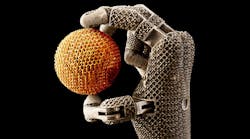Top Five Metal 3D Printing Predictions for 2016
The additive manufacturing is closing yet another explosive year of growth.
In 2015, we saw hundreds of exciting new applications of the technology popping up across the industrial market – from 3D printed houses and bridges, to flight ready rocket engine components and hybrid machine tools. Last year was the year additive manufacturing was finally accepted into the hardcore manufacturing world.
Going into 2016, we can only expect this progress to continue.
To that point, analysis firm, SmartTech, has put together a few predictions for the metal printing industry this year:
5. Small Footprint Metal AM Systems Will Drive Growth
Lots of noise have been made regarding the next generation of massive, production level, metal 3D printing systems announced in 2015 -and for good reason. Industrial scale solutions will no doubt be in demand to serve applications in aerospace and medical industries for regular production of end use metal components. 2014 and 2015 were characterized by huge sales revenue growth from large format metal systems sales.
However, in 2016, SmarTech anticipates that the market will see the beginnings of a shift to growth in smaller footprint systems aimed not just at research applications, but for true small-scale manufacturing opportunities for new industries where customers may want to start their additive manufacturing activities small and then scale them up over time. These systems are expected to play a middle role in between metal 3D printing services, and large format, production level metal AM systems utilized in-house.
4. Alternative Print Material Feedstocks Enhance, Not Threaten, Opportunities for Metal Powders
Metal AM isn't just about powder bed fusion or powder based directed energy deposition, but also wire based additive manufacturing as well as newly emerging processes such as the recently announced Xjet liquid metal nanoparticle based system.
For next year, wire based technology will likely grow almost entirely through the aerospace industry, but interest in this rapid and large format approach to near net shape layer manufacturing will no doubt attract interest from other potential industries in the future. While some competitiveness exists between wire based approaches and powder based approaches, SmarTech generally believes that neither approach will limit expansion of any other at this stage in the metal AM market's evolution. We would stress understanding the pros and cons of each technology and the underlying principles which dictate the potential applications for any metal AM process regardless of print process and material feedstock.
3. Automotive Industry Will Invest Significantly in Metal Systems for R&D
Historically a leading user of polymer 3D printing technologies for rapid prototyping and tooling applications, the automotive industry continues to (slowly) advance their use of true additive manufacturing within the limitations of the economic factors governing commercial automobile production. In 2016, SmarTech believes the time has finally come for concerted and more widespread investment in direct metal printing technologies from the world's largest automobile manufacturers.
2016 probably won't become the year that tens of thousands of metal automobile components will be printed for direct use in cars, but SmarTech does believe it will be a year where R&D and indirect additive manufacturing using metal systems will be catalyzed, resulting in significant dollars being spent. The big question that remains to be answered is, will these dollars go to service providers serving automotive customers, or will they be used to bring metal printers in-house?
2. Growth in Metal Powder Supply Chain Will Struggle to Keep Pace With Demand
It's no secret that a vast metal powder supply chain exists today to serve the broader powder metallurgy industry and its use of sintering, hot isostatic pressing, metal injection molding, and more -with many of these non-additive processes facing significant growth in their own right. However, as metal additive manufacturing is increasingly utilized for end use component manufacturing in increasing volumes, a strain on the supply chain for qualified spherical metal powder from verified and approved sources is entirely possible.
It's one thing to print objects in powders that are deemed 'useable for AM' (of which there is likely no threat of a shortage), but what could potentially cause constraints is in the supply of high quality, defect-free metal powder in specific alloys which is intended to be utilized for very specific end use applications in medical, aerospace, and possibly other industries. The market has begun to respond in 2015 with several notable providers scaling up operations. However, with nearly a 90 percent growth in installed systems in 2014 and possibly another 50 percent growth in 2015, will the market be able to keep up as customers begin to advance the goals of their already established internal AM programs?
1. Metal Additive Manufacturing Will Become the Focus of Major 3D Players
Some of the biggest names in 3D printing are on pace to miss early year 2015 growth targets, bringing about a drawing back from the investment community in publicly traded 3D printing firms. While its unsurprising to us that lower than expected growth from Stratasys and 3D Systems would result in reduced valuation of other, largely unrelated publicly traded 3D printer manufacturers, the reality is that the entirety of the 3D printing industry grew at a healthy pace in 2015 regardless of the growth targets of two leaders.
The most readily apparent implication that will result in 2016 from this scenario is a refocusing on areas of 3D printing technology where growth continues to explode. One such area is, obviously, metal additive manufacturing. Those wholly involved in metal printing solutions will likely continue on their uninterrupted growth journeys in 2016, while those only partially involved or entirely uninvolved will no doubt look to set their sights on this area in order to satisfy investors and sure up long term strategies.
Read SmarTech's full additive manufacturing analysis here.










